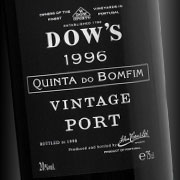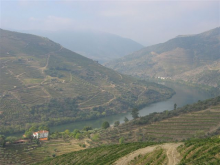I understand that some Port aficionados in the U.K. are said to consume an entire bottle of Port in a single day. Every day. I love the stuff, but I’m not quite in that league. There is a time and place for Port.
 Most often it is in front of my fire, with a hunk of Stilton following a meal. There is something about the crackle of a log on the fire on a cold winter night that nurtures the craving for fortification. At other times I wouldn’t even be tempted to indulge in this inky black, sweet libation.
Most often it is in front of my fire, with a hunk of Stilton following a meal. There is something about the crackle of a log on the fire on a cold winter night that nurtures the craving for fortification. At other times I wouldn’t even be tempted to indulge in this inky black, sweet libation.
During a summer visit to Portugal’s Douro Valley, where authentic Port is made, I barely touched the stuff, concentrating instead on the increasingly attractive table wines of the region. But the seasons have turned and I now find myself reaching for the bottle of Graham’s Six Grapes before I sink into my soft leather chair for the evening.
There are two basic types of Port (three, actually, if you count the rare white Ports that are usually made less sweet and served as an aperitif) and I have my own peculiar habit of taking bottle-aged ruby Ports – including Vintage Port – with savory cheeses, while I prefer a tawny Port with dessert.
That’s just me. You might do exactly the opposite and no one would say you were wrong. My thinking is that strong cheeses mask the subtle aromas of tawny. A good ruby has the power and primary fruit to take strong food flavors head-on.
There are essentially four classes of ruby that I favor, beginning with the supple ‘vintage character’ Ports such as Fonseca Bin 27 and Graham’s Six Grapes. These are a step up from generic ruby Ports, which generally aren’t very interesting. Most vintage character Ports retail for less than $20 a bottle, and deliver a big bang for the buck. And you can open a bottle and keep it on the shelf a couple of weeks and still enjoy it.
 At the next level are the vastly underrated Late Bottled Vintage Ports. These wines carry a vintage date, but typically are produced only in years when a vintage is not declared. They have neither the concentration nor the structure of a Vintage Port, but in some years they come close. They generally spend a little more time in barrel before bottling, to soften the tannins and make the wine more drinkable upon release. Dow’s, Taylor Fladgate and Fonseca all make excellent LBV Ports.
At the next level are the vastly underrated Late Bottled Vintage Ports. These wines carry a vintage date, but typically are produced only in years when a vintage is not declared. They have neither the concentration nor the structure of a Vintage Port, but in some years they come close. They generally spend a little more time in barrel before bottling, to soften the tannins and make the wine more drinkable upon release. Dow’s, Taylor Fladgate and Fonseca all make excellent LBV Ports.
The sleeper Ports are the single-quinta Ports made from the best vineyards of the great Port houses. A quinta is a farm, or vineyard property, and the top vineyards generally produce exceptional wines even in years when the overall quality is not good enough to declare a vintage.
At Graham’s the top quinta is Malvedos, at Dow’s it’s Quinta do Bomfim, at Taylor’s it’s Quinta de Vargellas. All of the big Port houses have some vineyards that yield high quality nearly every year. Wines made from those properties carry a vintage designation, though they are not considered ‘Vintage Port’ in the classic sense.
Consumers are wise to snap up the good ones, for they are generally priced 30 to 40 percent below the price of a Vintage Port from the same house, but the quality isn’t that different. I recently had a 1965 Graham’s Malvedos that was absolutely gorgeous, so it’s obvious to me some of these single-quinta Ports will hold up over time just as a classic Vintage Port would.
Of course, Vintage Port is the ultimate in the Port world, and justifiably so. The best will improve in the bottle for many decades, developing a stunning complexity of aromas as they age. From great years, such as 2003 or 1997, Vintage Ports from the top houses start at about $75.
There is a time and place for these wines, as well. But for the moment, I am content with my vintage character Port, a nice cheese and a roaring fire. I am ready for winter.
8
